
Impressionism
Carot's vision of a stable, secure world was suddenly shattered before the end of the century by the work of the Impressionists, with their view of the world as in a state of flux, when the paintings of the Impressionists were put on public display for the first time in Paris. But once again, the rather carefree vision of the Impressionists was in turn replaced by the disturbed world of the Expressionists before the end of the century.
When the works of the Impressionists first saw the light of day in the 1870s, they were seen as something totally new as exhibition pictures. Compared to work previously exhibited, they were small, informal in composition, spontaneously painted outdoors, and depicting everyday scenes in bright pure colour. From the first exhibition in Paris in 1874, the work of the Impressionists was derided and mocked by critics and the public, and not treated as art at all. Yet by the turn of the century, their art was universally accepted, and the Impressionists had become rich and famous. Today, we look at nature in terms of the Impressionist vision and accept their paintings as a 'natural' way of representing the world.
THE IMPRESSIONISTS.
Highlight
The Impressionists were a group of young artists who rejected the official state art of the day as sterile, in its depiction of ancient heroes and myths.
The Impressionists were a group of young artists who rejected the official state art of the day as sterile, in its depiction of ancient heroes and myths. To them it was outdated and no longer reflected the concerns of people in a time of rapid change. Neo-Classical art, in its aims of order and permanency, reflected a world that had changed little for hundreds of years. With new inventions and discoveries - the railway and photography, for example - the world was now changing rapidly.
The first Impressionist exhibition of 1874 was organised in opposition to the official State sanctioned exhibition of the Paris art academy known as the Salon. In order to qualify for entry to this exhibition, artists had no option but to paint in the traditional manner. The group of Impressionists refused to toe the official line and organised their own show.
A pointer to the changing times in the 1870s was the emergence of a new wealthy middle class in France with enough leisure time to enjoy their life as never before. These people were no longer interested in looking back to an ideal world of the past, or the portrayal of ancient heroes, whether religious or mythological. They were more interested in having themselves and their leisure-time pursuits reflected in a new art for the new age as they strolled through the streets of Paris or went boating on the Seine. It was the life of the great outdoors, and the new artists came out to paint it. While previous artists like Carot for example, painted real landscapes, these works were painted in the studio from sketches made outdoors.
The Impressionists, on the other hand, came out and painted outdoors. Their motto was, 'paint what you see'. Their art was said to be realistic. If what you see is shimmering light, or mist or fog, then that’s what you paint. You don’t paint an ideal scene or resort to a perfect L shaped composition if that is not what you see before your eyes in the landscape.
Because of the importance they attached to observation, the Impressionists were said to be perceptual artists, as against the artists of the previous generation, who were conceptual in their approach. The conceptualists had an idea in their heads of how the world looked, while scarcely bothering to check it against experience. For this idea of a stable, unchanging reality, Impressionism substituted a transient reality. The world was in a state of flux. To capture moments of this, immediacy of vision and spontaneity were necessary.
NEW TECHNIQUES.
Because the Impressionists were essentially painters of light, and as light changes rapidly, new techniques were developed, dictated by the haste demanded. Rapid execution became the order of the day, giving the work a very casual but lively quality and leaving it looking unfinished. Hence the term 'impression'. Consequently, art is no longer seen as ideal or as an embodiment of permanent values. The world out there is no longer seen as perfect. There is less clarity of line and form, indicating that the old certainties are gone, and there is often no comforting centre of interest (for example, perspective lines leading on to a house) as in classical art.
SUBJECT MATTER.
Because light and atmosphere were really the subjects of Impressionist art, and because light can change rapidly, the subject can also change and can be painted under different lighting conditions and in different seasons. Anything in the landscape could be a subject, painting easels could be set up anywhere. The Impressionists rejected the historical subjects of Neo-Classical painting which they saw as an art for the educated classes. Like the previous realist painters they painted landscapes and ordinary people, with the emphasis now on enjoyment and relaxation, the world as they saw it. It was an art for the people. The upper classes found it difficult to come to terms with the new realities.
THEME OF IMPRESSIONISM.
Impressionist art is characterized by liveliness, excitement and pleasure, The idea was that we are here for a while. There is no permanence. We cannot capture the whole of reality in the deep perspective of the Classicists. We must be satisfied with fleeting glances that can rapidly change. But the world is wonderful, let's enjoy it. Impressionism is a celebration of the harmony in nature and between man and nature. This art is like a mirror reflecting life as lived by the artists and their contemporaries. The theme of Impressionism is the world as a reflection of the grandeur of God.
MONET INFLUENCED BY BOUDIN.
Claude Monet was the leader of the Impressionists. He was born in Paris in 1840. At the age of five his family moved to La Havre at the mouth of the Seine. Most of his paintings were done around the Seine valley. In his youth he did comic drawings of people and later met the painter Eugene Boudin (1824-1898) who introduced him to painting outdoors.
EUGENE BOUDIN
Boudin had a greater influence on Monet than any other pre-Impressionist artist. He was little known in 1857 when he took the young Monet with him one day as he went to paint in the countryside. Monet later said, 'it was as if a veil was torn from my eyes; I understood what painting could be.' He discovered there and then that landscape painting from nature was his true vocation. He said all he ever wanted to do was 'depict the impressions made on me by the most fleeting effects'.
Fashionable Figures on the Beach, 1865. Museum of Fine Arts, Boston.
This painting is an advance in a number of ways from the work of Courbet and Carot. Although Courbet painted real people in outdoor settings - Burial at Ornans, for example- he differs from Boudin in his dark tones and in his depiction of peasants. Figures in Carot's paintings were only included for the purpose of creating a focal point or to give scale to the landscape. His pictures were painted in the studio from sketches made outdoors. Woman Reading on a Wooded Bank is an example.
This picture was painted outdoors on a Brittany beach. At this time there was a growing taste for tourism among Parisian middle and upper classes.
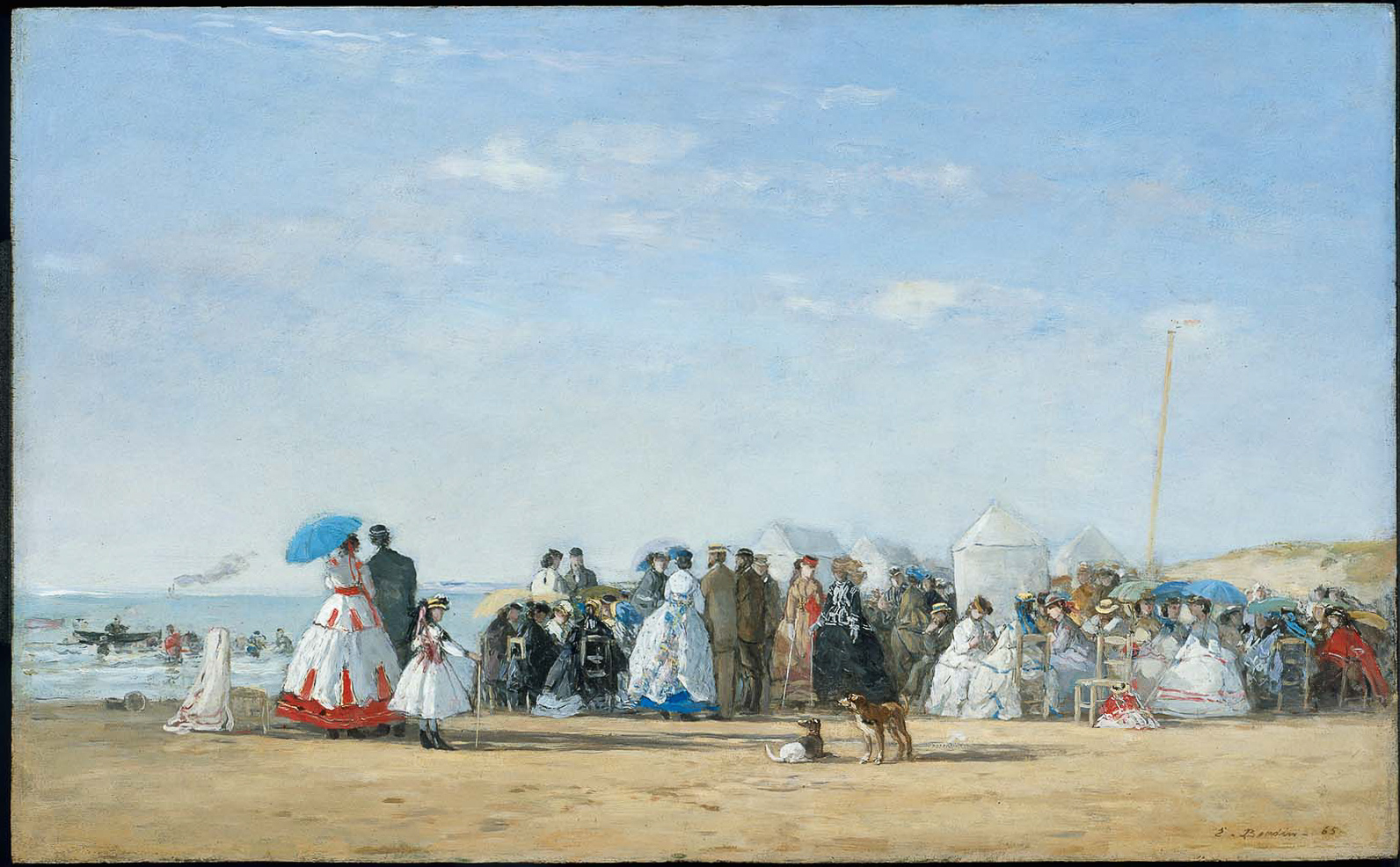
Boudin displays his acute sense of a bright day and keen eye for costume to depict this group of fashionable tourists on the beach at Trouville. He painted many pictures of this type, finding a ready market among the wealthier classes depicted in them.
Figures on the Beach, 1893. Museum of Fine Arts, Boston.
Fashionable Figures has much in common with later Impressionist work in its bright tonality and pure colours, especially in the costumes, and in the fact that it was painted outdoors. It differs from an Impressionist work in its overall smooth textures, high finish and in its lack of broken colour. Boudin, in his later work, concentrated on less detailed, more atmospheric scenes where the figures were reduced in scale, and atmosphere and the panoramic landscape were to assume much greater importance.
His Figures on the Beach, 1893, is such an example. Here, the figures – tourists, boys fishing and gathering shellfish, and the distant horse and cart - are reduced in significance compared to his earlier Fashionable Figures on the Beach. The emphasis is more on the landscape, the movement of the clouds and the motion of the water. The palette of dark blue and green captures the atmospheric effects of the rainstorm threatening on the horizon. It could be said that Boudin beautifully created an impression of an impending storm in his broad sweeps of the brush. The painting has the unfinished look of an Impressionist work, but the artist clearly considered this loose, sketchy painting finished because he signed and dated it. However, the painting differs from an Impressionist work in its lack of broken dabs of pure colour and its emphasis on tones. Boudin is content to paint the sky in varied tones of the same blue where the Impressionists might have observed subtle variations of related colours. See Monet’s The Red Boats.
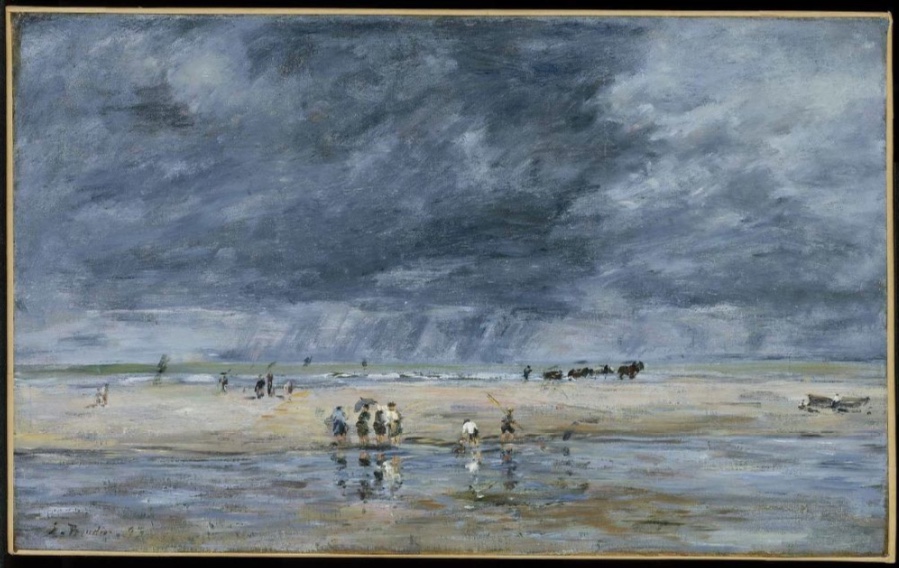
CLAUDE MONET AND THE IMPRESSIONISTS.
Claude Monet's earliest paintings were done in the studio from sketches made outdoors. The Pointe de la Heve at Low Tide 1865, Kimbell Art Museum, Fort Worth, Texas was accepted by the jury at the Salon exhibition of 1865. This picture is very much in the tradition of Carot in its almost perfect finish, its emphasis on tones, and in its muted colours. It is one of his pre-Impressionist works and can be contrasted with his paintings of the 1870s. However it is worth noting the subtle colour variations in the sky.
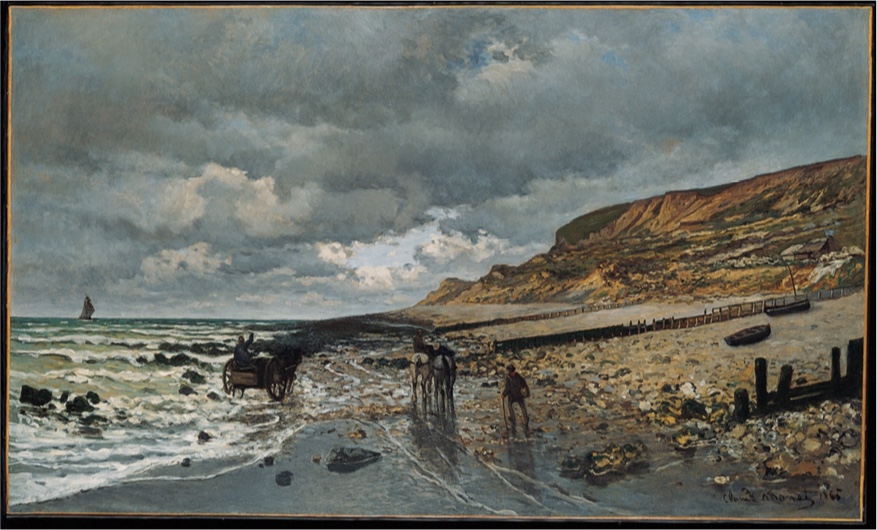
ARGENTEUIL.
Monet went back to Paris to pursue his studies in art in 1859. There he met Renoir, Pissarro, Sisley and other young artists with whom he discussed the new approaches to painting. He rented a house at Argenteuil, a village on the Seine a few miles from Paris and married Camile who was to feature in some of his work (see Lady with a Parasol). His best Impressionist work was done in the 1870s at Argenteuil.
A comparison between an early and a later painting by Monet will illustrate how his style developed towards full Impressionism.
Riverside Walk at Argenteuil 1872. Kimbell Museum, Fort Worth, Texas The earlier painting is quite traditional in its L shape composition, its emphasis on linear perspective, clarity of line, sharp tonal contrasts and smooth brushwork - especially in the sky. Only in the modernity of its subject and in its pure colours does it stand out from the landscapes of Carot and Courbet, or from his earlier work, The Pointe de la Heve at Low Tide for example.
In The Red Boats, Argenteuil, Paris, Orsay Museum. Monet conveyed the shimmering light of a summer’s day by the use of broken colour and short flecks of paint, making the texture less smooth throughout than in the earlier painting. The colour, too, is variegated, especially in the sky, in place of the simpler and broader areas of colour of Riverside Walk, which contains mostly blue, but with a subtle brushing of pale purple in the lower sky.
This distribution of colours gives The Red Boats great colour harmony, while at the same time allowing for lively contrasts of orange and blue in the middle distance. In the true Impressionist style, the picture relies on colour rather than tonal contrasts. In the trees, the transition from light to shade is expressed by gradations from yellows and yellow-greens to soft blues, the same blues picked up in the water reflections. The shadow side of the boats is a reddish purple, the next darkest colour to red. These are examples of modelling in colours rather than tones. Textures throughout are mostly rough.
This painting also demonstrates Monet's increasing concern with painting bright, shimmering light. The objects in the painting, especially the figures on the river bank, the trees and buildings in the distance, all are dissolved in the light, a demonstration of aerial perspective as against the linear perspective of classical art.
Impression Sunrise, 1872. Paris, Marmottan Museum. More than any other work this picture sums up the aims of the Impressionists. It was exhibited in 1874 at the first Impressionist exhibition. Because of its unfinished look, one of the critics of the day christened the whole group 'Impressionists'
The picture shows the port of La Havre in the mist. It was painted very rapidly with broad sweeps of colour without any details. Because Monet's motto was 'paint what you see' rather than what you know to be there, and because light and atmosphere can often throw a veil over objects, he was more concerned with light and atmosphere than depicting objects in the real world. In order to achieve this he made use of soft brush strokes to suggest the pier, chimney stacks and the masts of ships. The eye-catching details of the men in boats in the foreground are sketched in a darker tone and with a clearer line. The rippling effect of the water is achieved by dark strokes placed over lighter colour. Brushing cold blues over warmer oranges produces the desired effect of transparency in both sea and sky. The dominant blue of the painting contrasts beautifully with the areas of orange, the sun and its reflection emerging as the strongest colours, other colours more muted. Good for a response in creative writing.
In the 1870s, Monet's work was mostly small pictures, roughly thirty inches wide. These were not considered important enough for the Salon. By including paintings like these in their own exhibitions, the Impressionists were creating a new norm for exhibition painting, that an outdoor sketch, less elaborate and spontaneously done, could be exhibited and recognized as a finished painting.
Snow at Argenteuil, 1874. Museum of Fine Arts, Boston. This painting is another fine example of Monet's early Impressionist work. Here, the effects of light and atmosphere can be compared with Impression Sunrise. The colours are more muted, and there is an overall grey-green colour harmony. In Snow at Argenteuil, while maintaining an overall even tonality, the contrasts are more of tone than of colour. The darker tone of the nearer deciduous tree on the left, for example, contrasts with the lighter tone of the tree in the distance.
The light-grey canvas, which establishes the finished tone of the painting, can be seen through some of the thinly applied brushstrokes. Quick strokes and dabs of paint define the objects and the people. The typical impressionist dabs of colour are very much in evidence in the snow-speckled meadow. With the artist himself, as he painted, we can feel the cold, damp air and the falling snow.
The so-called unfinished look of the picture would have been unacceptable to the previous generation of artists, and still had little appeal to the public on whom Monet depended for support.
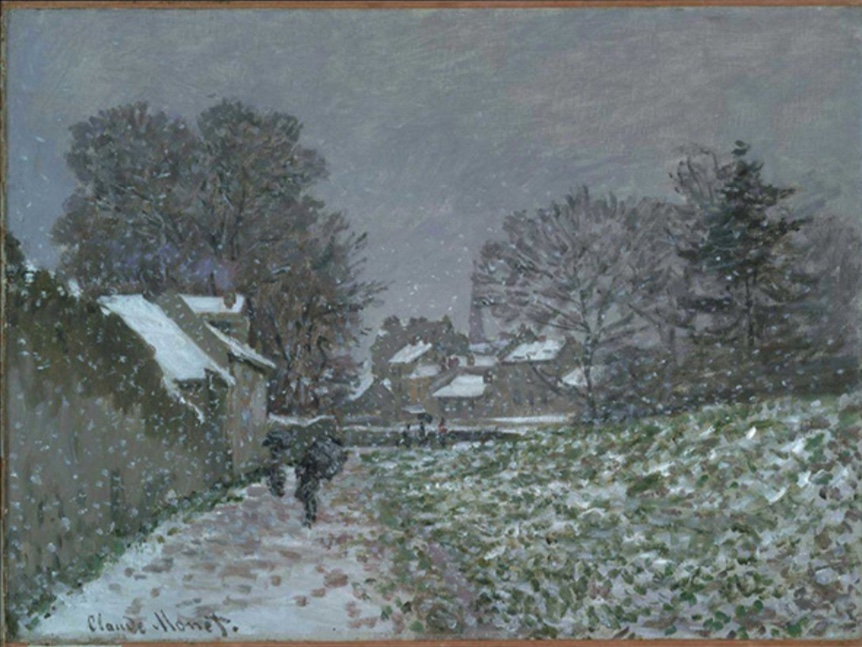
VETHEUIL
Monet moved to Vetheuil a rural village further down the Seine in 1878 where he did a number of paintings. He painted Lavacourt across the river from Vetheuil in all weathers and seasons. One of his Lavacourt scenes, Lavacourt in Winter, can be seen in the Hugh Lane Gallery, Dublin.
Concerned as he was with the effects of light, Monet painted pictures in all weathers. These included a number of snow scenes. In this depiction of winter in Vetheuil, the frozen rut-filled road leads past his rented house on the left. With the typically broad jabs of muted browns, greyish greens, violets and blues, he suggests the barren slope of the hill on the left, as well as the chunks of ice on the river on the right. The hills beyond, brushed in blue, grey and white, rise into the leaden sky of a late afternoon of mid-winter.
The muted colours and dark tones seem to reflect the artist’s mood of desolation. Monetentered a period of deep sadness. At this time he was poor and his wife Camille had just died at the age of thirty-two.
INFLUENCE ON MODERN ART.
Developments in modern art can be traced to works of the Impressionists. Among their innovations was their use of strong pure colours, contrasts of colour rather than of tone, their use of broken colour, their employment of different textures to describe a variety of objects, the ‘unfinished’ character of their work due to rapid painting outdoors, and their general aim of depicting the effects of light and celebrating the beauties of the natural world. Where the previous generation of artists tended to employ a uniform smooth finish, the work of the Impressionists was recognized for its visible brushwork, lack of detail and finish. The development of modern abstract art can be traced to paintings like Impression Sunrise where the artist placed more emphasis on colour and texture, and the art elements in general, than in the clear depiction of objects in the real world.
Woman with a Parasol, Claude Monet 1876. Washington, D.C., National Gallery of Art.
This painting is an illustration of all that is essential in Impressionism. We get a fleeting glance of a woman and her child, probably Monet’s wife, Camille and their son, as they stroll through the fields on a summer’s day. In a sense it is almost like a snapshot, as if she had just turned around to get her picture taken. Compare this with the static, ordered composition of Granacci’s The Holy Family.
Here is real everyday life compared with the idealized world of Granacci. In Monet's picture the moving figure is almost dissolved in the blue of the sky, her white dress reflecting the same blue. The yellow of the clouds and the flowers are also reflected in her dress. The tonality is even and bright. Notice the variety of textures Monet employs to denote sky, clouds, dress and grass. The artist is not concerned with any emotions or feelings. His aim is to convey an impression of a figure in the landscape and to describe a beautiful scene. We can share in his sense of wonder at the great outdoors.

Grainstack (Sunset) 1891, Claude Monet. Fine Arts Museum, Boston.
Grainstack was exhibited in the National Gallery special exhibition for the opening of the new wing in 2,000. It belongs to a series of at least twenty-five canvases that Monet painted of this subject in 1890-1891. It belongs to his middle period when he had come more and more to the view that a subject for a painting mattered little. What was of greater significance to him was the depiction of light and atmosphere. He found that the same objects could be painted again and again under different light, atmospheric colour and seasons.
In colour harmony, the warm colours dominate the picture. These are contrasted with the cooler blues, purples and greens.
Viewed from a distance in the art gallery, the effect is as if some hidden magical light glowing through the canvas. Part of the secret must lie in the broken colour style of the Impressionists. The lower part of the grainstack, on close-up examination of the painting, will reveal the effect of broken colour. Here, Monet has superimposed a mass of rapidly applied twisted dabs of red-orange paint on the still-visible brownish-purple underpainting, and as a contrast to the underpainting. This gives an effect of light, which could not have been established by mixing those two colours on the palette and then applying them to the canvas. The result would look flat and dull. With broken colour, the viewer optically mixes the colours from a distance, and the effect is almost miraculous. Compare the above picture with Haystack in the Snow, 1890. Museum of Fine Arts, Boston.
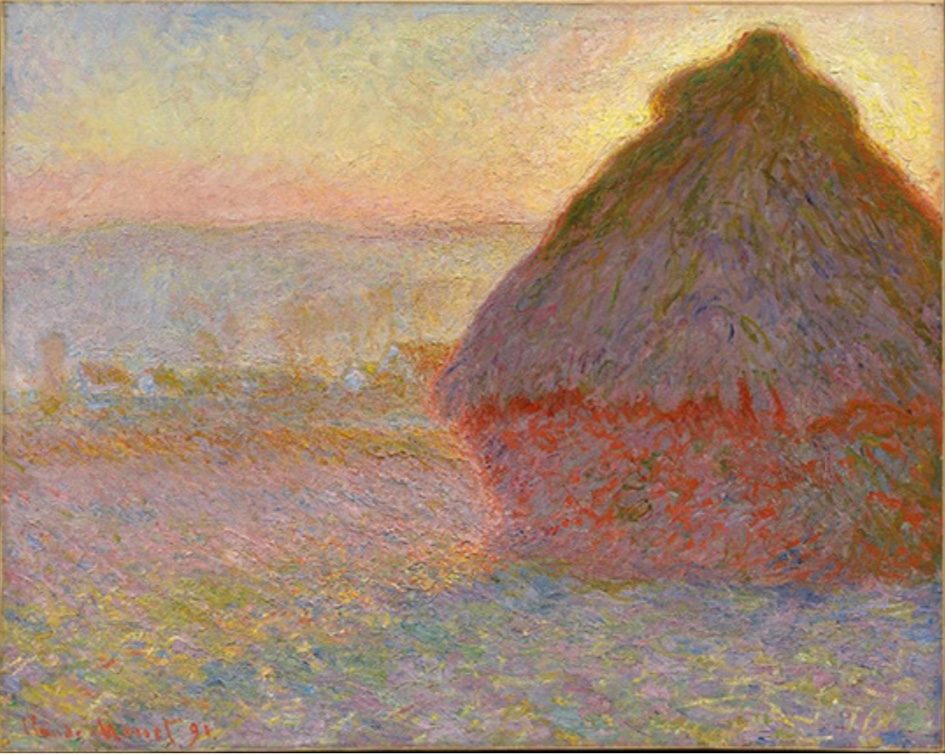
It must be said that the effect just described can scarcely be detected in reproductions of this, or indeed of many other paintings, and can only be appreciated on a viewing of the original work.
Monet never went out of his way seeking grandiose subjects for his art. A few stacks of hay or grain, a grassy field with a hedge in the background - anything could be a subject for his art. Claude Monet's vision was realised in the transfiguration of the commonplace. This was his unique contribution to the history of art and to our understanding of the world.
AUGUSTE RENOIR
The Swing. Auguste Renoir. Orsay Museum, Paris.
Because they painted outdoors, the Impressionists suddenly noticed a whole new range of bright colours. They saw that shadows were reflected light and contained a lot of blue and purple. Renoir’s, The Swing is an illustration of this. Short broken dabs of yellow and blue suggest light and shadow. Although people dominate the picture, and are obviously enjoying themselves, Renoir is mainly interested in the effect of light filtering through leaves and colours reflecting on faces, clothing and ground, rather than exploring depth of feeling. Dappled, rosy daubs alternate with blue, lavender and brown brush strokes to create the effect of sunlight and shadow. The Swing, representing the pleasure principal of Impressionism, is also typical Renoir. ‘For me a painting should be an agreeable thing, joyful and pretty, yes pretty’, wrote Renoir.
As in other Impressionist paintings, figures and trees are partly dissolved by light, leaving outlines softened and blurred, which is why a soft line is much in evidence in Impressionist painting. This gives the picture a gentle pastoral quality. Compare the soft line of this painting with the clarity of line of Classical painting and the hard line of the Expressionists.
For discussion purposes, ask the children if they think this is a happy painting, and if so, why? Do you think Renoir was a happy person?
The Swing can also be compared to Moulin de la Galette, again as an illustration of Renoir’s belief that ‘a painting should be something you love to look at; something happy and beautiful’.
Moulin de la Galette, 1876. Pierre Auguste Renoir. Orsay Museum, Paris.
Renoir used the local shop girls and seamstresses who came to dance at this café as models for the painting. Here again we see a departure from the classical ideal and the belief that only heroic figures from history could make fit subjects for art. The Impressionists on the other hand showed how ordinary people in their everyday life could be celebrated. Perhaps this was the main reason why they were so slowly accepted and appreciated.
LIMITS OF IMPRESSIONISM.
The art of the Impressionists is essentially descriptive – they painted what they saw, as they saw it. This left little scope for a personal approach based on the expression of feelings. At the same time, each artist developed his/her own individual style, and the work of different Impressionists can be compared. But these artists were not interested in exploring human feelings. For them, the human figure was just one more fleeting object partly dissolved by light. Some Impressionists, however, were interested in humanity.
Renoir did a lot of figure painting but his people are not shown in a reflective mood. See The Umbrellas, by Renoir, one of the paintings of the Hugh Lane collection in The Hugh Lane Gallery, Dublin. They are not the isolated individuals you find in Expressionist art. Monet, Renoir and their friends saw themselves as members of society. Their subjects are depicted enjoying themselves in a social context and apart from that the viewer is not presented with any great depth of feeling.
For a personal approach and the portrayal of strong feelings, we must look to the Expressionists who followed them. The later artists felt that Impressionism was too ephemeral, lacking in structure and failing to take account of objective reality - the world as it is, rather than as we see it.
See also the following works by Claude Monet: Argenteuil Basin, 1874, National Gallery of Ireland; The Boulevard des Capucines 1873, Nelson-Atkins Museum of Art, Kansas City, USA; Red Poppies at Argenteuil (The Field of Poppies) 1873, Orsay Museum, Paris; Haystack in the Snow 1890, Museum of Fine Arts, Boston; Regatta at Argenteuil 1872, Orsay Museum, Paris, Waterloo Bridge, 1900, The Hugh Lane Gallery Dublin; Renoir, The Seine at Asniers 1879, National Gallery London; Renoir, On the Terrace 1881, The Art Institute of Chigago; Renoir, Country Footpath 1875, Orsay Museum, Paris; Berthe Morisot, Summer Day 1879, National Gallery, London; Alfred Sisley: Misty Morning,1874, Orsay Museum, Paris.
Impressionist Artists: Claude Monet, Camille Pissarro, Alfred Sisley, Auguste Renoir, Berthe Morisot, Edouard Manet.
